Bodyweight Skill Integration
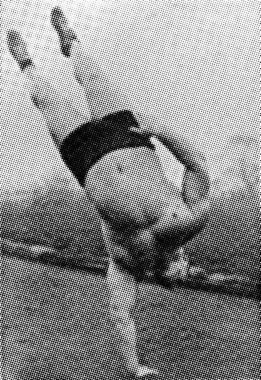
I admire the strongmen and women of old. Here were people who could move a mountain of iron yet could also control themselves in various bodyweight strength, acrobatic, and balancing skills. And why shouldn’t they (and we) be proficient with both the weights and our bodies? As it’s been said, “Handbalancing to a bodybuilder, a weightlifter or any barbell man, is as natural as a duck taking to water.”
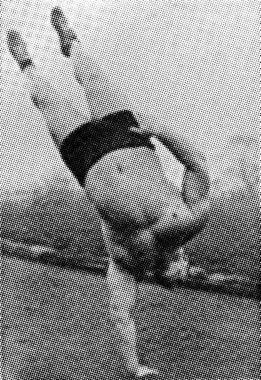
Bert Assirati
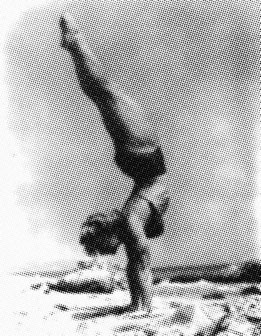
Pudgy Stockton
Both weight training and bodyweight skills create muscular tension and test the body’s ability to coordinate itself in a single task. Yet I feel being able to move and control your body builds a unique strength and coordination that weights can’t quite match, and vice versa. This is the reason I’ve included various bodyweight skills alongside my weight training for quite some time. I also include both in my workouts because I enjoy training each one. Is any other reason really needed?
Now when I talk of bodyweight skills in this article, I’m talking of both static positions (e.g. planche, handstand) and those requiring joint movement and range of motion (e.g. one arm chin, one arm pushup). The term skill also assumes an above average amount of strength and/or balance to perform.
When I name a skill, I’m also referring to any lesser progressive skills and exercises. So this means easier skills that match one’s current strength level as well as any other work one might do to achieve the named skill. I have not elaborated greatly on all these progressive exercises and skills, though, as it would turn this article into a very long list of tutorials.
Strength Skills:
Complementary Combinations
When attempting to integrate bodyweight skills into your workout, the first inclination is to continue your regular weight training routine and tack on the various skills wherever you see fit. Problems often arise, as you may do too much work during the week and not allow the body to properly recover. You may also fatigue the body too much during a workout and interfere with other exercises in your program. Another problem is the lack of focus you’ll feel when trying to cover several dozen different exercises in the same training week.
A better alternative comes in understanding how various bodyweight skills and weight training exercises complement each other. Working on one will show a carryover and improvement in the other. Instead of including both during a training session, you can switch back and forth as needed. It’s the concept of “same, but different.” The same general movements and muscles are worked, but in different ways. You’ll still need to spend time practicing the skill, working through its various progressions, and learning its subtleties, but now you won’t feel that you’re completely neglecting a skill as you work on a complementary weight training exercise.
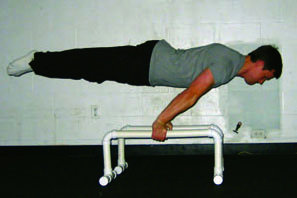
Planche
This is by no means a comprehensive list, but should get you thinking about the various combinations you can put together. I’ll elaborate how to work these combinations into your training routines later in the article.
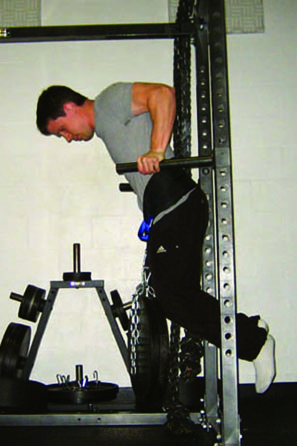
Weighted Dip
Planche: Weighted dips, weighted pushups, decline and flat bench pressing (barbells and dumbbells)
I’ve found working weighted dips to be one of the best exercises to compliment planche work. The dip builds up the strength in the pressing muscles of the chest, shoulder and triceps at a similar angle. Also important is the fact that the scapulae can move freely during the exercise. In fact, I find it essential to make sure to press up as much as possible at the top of the dip, mimicking the press needed when holding the planche.
Working on weighted pushups also allow for scapular movement, as well as the added challenge of keeping the midsection tight. They generally don’t allow for as much added weight as a dip, though.
The decline and flat bench press are included because they will improve general pressing strength. In fact, it’s often said that some Olympic gymnasts who posses a high level of planche strength can bench-press nearly twice their bodyweight the first time they try. While this may be just an urban legend, the exercises should help the planche to some degree. They do not allow the scapulae to move as freely as in the weighted dip, though.
One arm pushup: One arm dumbbell chest press, weighted dips, any bench press (especially close-grip)
The one arm pushup is a skill requiring good horizontal pushing strength and the ability to generate tension through the body. The one arm dumbbell chest press accomplishes both of these things. There is a difference, though, in the exact tension needed throughout the body. The one arm pushup requires cross-body tension from the pressing hand to the opposite foot while the one arm dumbbell chest press requires tension from the pressing hand to the same side foot. Despite this, learning to keep a unilateral tension in the body while pressing will help the one arm pushup.
The bench presses and dips are again included, as they will increase general pressing strength in the horizontal direction. The close grip bench press is particularly recommended, as the arms are close to the sides, just like the one arm pushup. Such a position focuses on and helps strengthen the triceps.
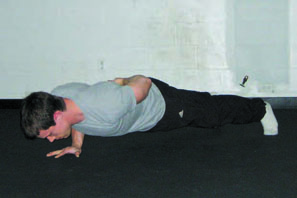
One Arm Push-up
Front lever, Back Lever, Muscle-Ups, One arm Chin-ups/Pull-ups: Weighted Chin-ups/Pull-ups, One Arm Rows, Weighted Rack Rows, Bent-over Rows, Pullovers
The common factor among all these skills is the need for a high level of back strength. While the weighted chin-ups and pull-ups seem to be the most complementary to other vertical pulling skills (such as the one arm chin-ups/pull-ups and muscle-ups), one should not discount heavy rowing to help these skills as well. Rowing will especially help you pull the elbows back and finish strong and high above the bar for the one arm chin-ups/and pull-ups.
The front lever is a skill that requires a great deal of upper body tension and a lot of back involvement. It is often said that the skill doesn’t even need to be trained; that heavy pull-ups will be sufficient to build the strength. I’ve found this to be true to a certain degree. You’ll still have to practice the front lever, but once you can do a pull-up with 100 extra pounds around your waist, you’ll find the front lever much easier! The pullover is also included in the list as a complement to the front lever. Muscle recruitment is very similar, even if the midsection is not stressed to as great a degree.
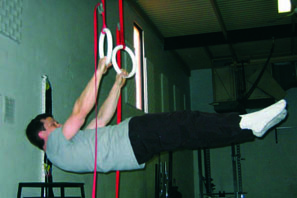
Front Lever
The back lever will also come about with heavy weighted pulling and rowing exercises, even easier than the front lever in my experience.
Now in the choice between chin-ups and pull-ups you should definitely work both, but I’ve found a better carryover to the front lever with weighted pull-ups due to the similar line of pull and muscular recruitment of the back and biceps. Specifically, I keep my elbows about shoulder width apart when I pull instead of flared out to the side. This feels remarkably similar to a front lever.
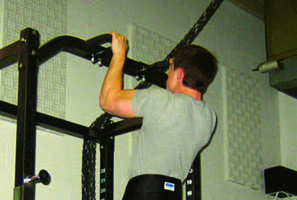
Pull up
Pulling in this manner will also carryover very well to the muscle-up (on the rings or a bar). The muscle-up is another skill that some may find doesn’t need to be trained often (or at all) if one is doing heavy pull-ups. Building up your maximal strength through weighted pull-ups will allow you to fly through the sticking point of this skill—the point where one transitions from pull-up to dip.
Handstand pushups, Simple Handstand Press: Military press, Push press
The military press and handstand pushup are perhaps the most obvious of the skill-weight training combinations. Each is going to increase your vertical pressing strength in a very similar way. Make sure to work the handstand pushups in a full range of motion with shoulders lowered all the way down to the hands in order to see the greatest carryover to the military press.
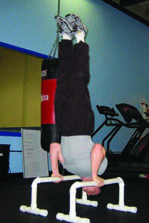
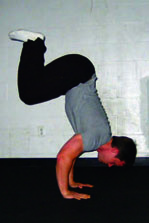
Handstand Push-up, Handstand Press
The biggest difference to point out is a greater demand for torso stiffness and stability with the military press, while the handstand pushup, especially freestanding away from a wall, will require a greater sense of balance.
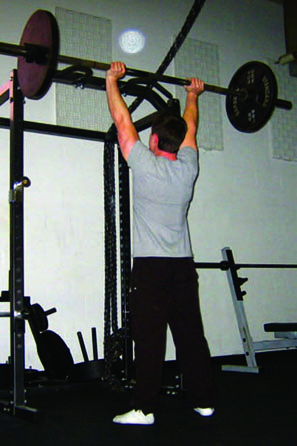
Military Press
The push press has the advantage of putting the weight over the head with help of the legs, then lowering it down slowly. This is quite similar to the progressive means of learning a handstand pushup where one lowers oneself down from the top of a handstand to the floor.
The simple handstand press, where one presses into a handstand from a squatting position, will greatly benefit from the increased shoulder strength that the military and push press provide. Practice will still be needed though to learn the balance for this skill.
One arm handstand pushup: One arm shoulder press, One arm push press
Both the one arm versions of the handstand pushup and overhead press have different techniques then their two arm brethren. Most notably is the ability to “press off the lat.” By flexing the lat you can create upper body tension and control the movement better.
With any one arm handstand pushup work, you have the advantage of using the other arm for assistance - something that is too awkward to do smoothly with the shoulder press. But with the one arm shoulder press, as with the two arm version, there’s the demand for greater muscular tension through the midsection.
The one arm push press will also allow the arm and shoulder to experience a higher load and degree of tension, which is essential for controlling the negative motion of any one arm handstand pushup work.
Pistols: Weighted squats, lunges, step-ups
When learning how to do a one legged squat, I have found the biggest limiting factor to be strength, not balance. And the more strength one has in their legs, the more one can focus on the balance. With that said, deep, weighted two legged squats are arguably the best exercise for the quad-dominant one legged squat. It should be noted that I’m referring to high-bar Olympic squats and not low-bar squats, which are hip dominant.
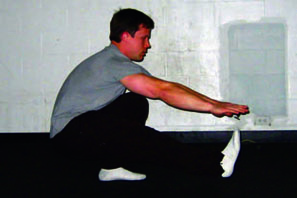
Pistol
Just about every other heavy, weighted exercise you do for the legs is going to help the pistol along in some way. Unilateral work such as lunges, especially overhead versions, will work to build up stability in the frontal plane. This should prove helpful if side-to-side balance in the pistol is a problem.
Iron Cross: Straight Arm Cable Pull-downs, Weighted Chin-ups/Pull-ups, Weighted Dips (especially on rings)
Of all the skills discussed so far, the iron cross will be one that requires the largest amount of specific skill training in comparison to its weight training complements. This is due to the highly unique activation and synergy of the muscles of the upper body.
Straight arm cable pull-downs to the side of the body most closely mimic the motion and unique muscular stress of the iron cross. Even still, there are ways to cheat the movement and give a false sense of progress towards the iron cross. In addition, shoulder positioning and balance on the rings still needs to be learned.
The other complementary weight training exercises listed will help to build up general strength in the chest and back, which are the two largest muscles activated during the cross. Exercises such as weighted ring dips, especially focusing on the hands turned out, offer a close approximation of the muscular stress of the iron cross.
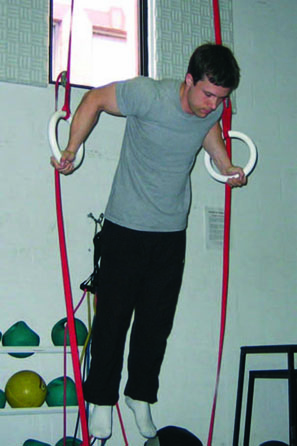
Ring Dip
Balancing Skills
When talking of balancing skills, I include such skills as the handstand, the headstand, and the two arm elbow lever. These are skills that require one to learn a delicate balance while inducing relatively minimal fatigue of the body during each attempt.
I also include one arm variations such as the one arm handstand and one arm elbow lever. These tend to be more strenuous though, so one should take note of the accumulating fatigue and plan accordingly, whether in less volume or different placement in one’s training, to prevent them from interfering with other workouts.
I do not include such skills like the planche in this group. Although it requires balance to perform, it is very fatiguing for most. You may reclassify certain skills based on your strength level, though.
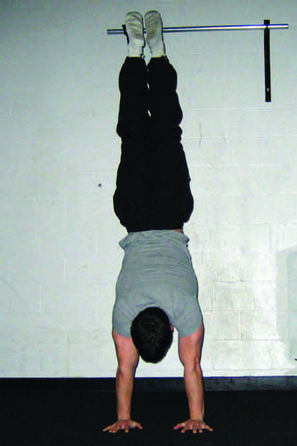
handstand
I find one can include these types of skills in their workout at the very beginning when fresh. Training the skills for just a short period of time at the start of each workout will help to keep the skill familiar, yet prevent excess fatigue for the rest of the workout to follow.
You may also practice these skills on the off days for 10-15 minutes. I’ve found that such small blocks of time taken on your rest days to mesh well without interfering with recovery.
You can also integrate the skills in short amounts of time throughout the day—a method commonly referred to as “greasing the groove”. Here you try to get as much quality work done throughout the day while staying as fresh as possible.
Remember that we are trying to teach the body to how to delicately balance, so the quality of the practice is diminished when overly fatigued. So whichever method you choose, stop practice when you become tired and your form becomes consistently worse.
Integration and Periodization of Skills
I don’t write this section to fully explain the various forms of periodization; there are numerous articles written on that already. I am also not giving complete sample programs. In an article that already presents the reader with several options to think about, I would like to continue by offering several more ideas.
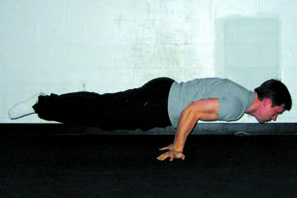
Elbow lever
Basic Integration
Let’s look at a simple four-day M-Tu-Th-Fr, upper/lower body split. Let’s assume we are able to both a front lever and a planche at this point and would like more proficiency at a handstand.
Monday – Upper
Weighted dips
Front lever
Tuesday - Lower
Handstand work
Weighted squats
Weighted lunges
Thursday – Upper
Planche
Weighted Pullups
Friday - Lower
Handstand work
Pistols
Deadlift
Notice how planche holds have taken the place of weighted dips as we moved from Monday to Thursday, while the front lever is replaced with weighted pull-ups. Handstand work is placed at the beginning of lower body workouts, but again may be placed just about anywhere if the volume is monitored.
Or perhaps we’re working a M-W-F, total body workout. A sample routine might look as such:
Monday
Bench press
Chin-ups
Lunges
Tuesday
Handstands throughout day
Wednesday
Military Press
One Arm Rows
Deadlift
Thursday
Handstands throughout day
Friday
Planche Holds
Muscle-Ups
Front Squat
You can devote as much or as little time to the bodyweight skills as you want. In the example above, there’s only one workout containing bodyweight skills, with handstand work done on the off days. You could just as easily include different bodyweight skills in two workouts, or even once every two weeks. The decision will be based on your goals.
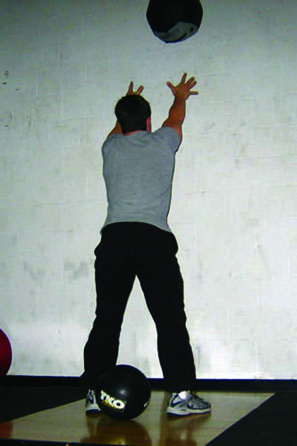
Wall Ball
Olympic Lifting and High Intensity Interval Training
When working the Olympic lifts, High Intensity Interval Training, or any other training modality that stresses the whole body at once, the bodyweight exercises can be integrated in several additional ways. Whichever you pick, care must be taken to track total volume and allow for adequate recovery.
One way to handle things is an AM/PM split where the total body workout is done in one half of the day, and the bodyweight skills done in the second half. This will allow for sufficient time to rest and recover between sessions. Keep in mind, though, that some level of fatigue will still exist. Placing an Olympic lifting session as the first workout in the day will help prevent any bodyweight skill work (done several hours later) from fatiguing the muscles and affecting power and technique. On the other hand, a high intensity interval training session may be best placed as the second workout in the day, so that strength is not compromised for the bodyweight skills. One can then just grind through the interval session with minimal compromise of training effect.
I would recommend only working two or three skills a day in this way in order to control fatigue. For example, work one pushing skill, one pulling skill, and a lower body skill. Alternate the different skills practiced throughout the week if needed.
Undulating and Conjugate Periodization
In a training program where the intensity and reps change often, or one that calls for both dynamic and maximal efforts, the bodyweight skills are easily adjusted. Rather than working at your maximal level for the skill, use an easier progressive exercise and change the repetitions or the speed at which the exercise is performed.
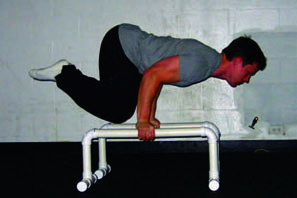
tuck planche push-ups
Let’s look again at a four-day, upper/lower split, this time the max effort days have a greater recovery surrounding them. We’ll assume again that the planche and front lever are maximal efforts. Pay particular attention to the fact that the muscle-up is used for a pulling motion on the upper dynamic day.
Monday – Lower Max
Pistols
Deadlift
Wednesday – Upper Max
Front Lever
Planche
Friday – Lower Dynamic
Jump split squats
Speed box squats
Saturday – Upper Dynamic
Tuck planche pushups
Muscle-ups
This particular routine happens to be fairly heavy on bodyweight exercises for the upper body, but one could just as easily substitute a speed bench on Saturday for the planche work.
Of course, one can have maximal and submaximal bodyweight skills in the same workout. For instance, working the planche as a maximal effort, and adding tuck planche pushups at the end for higher repetition, accessory work.
While this guide is not perfect for instances where one uses a dynamic exercise (pushups) to work on a static position (planche), it at least helps quantify the difficulty of progressive exercises.
When dealing with time-based skills, such as how long one can hold a planche or a front lever, simply take the percentage of maximal time held. Again, it’s not perfect, but it will give you something to measure if you so choose.
Deloading
(Back Off Periods)
When taking extended time to fully recover, simply pick an easier variation of the bodyweight skill you are working if you want to decrease the intensity but maintain the same volume. You can also decrease the number of repetitions or total number of holds for the skill if looking to maintain intensity but decrease volume.
If your maximal effort for a skill is one of the most basic progressions, it would be wise to pick an easier bodyweight exercise (pushups, chin-ups) or light weight training exercise to work.
Conclusion
The decision to start training for various bodyweight skills is completely up to you. I’ recommend them for the variation they provide, the well-roundness they can give to one’s athleticism, and just for the fun of them. Whether you’re just adding these skills into your routine, or have been working them for years, proper planning and integration will help to maximize the efficiency of your training and prevent overtraining, stagnation, and frustration.

Bert Assirati

Pudgy Stockton
Both weight training and bodyweight skills create muscular tension and test the body’s ability to coordinate itself in a single task. Yet I feel being able to move and control your body builds a unique strength and coordination that weights can’t quite match, and vice versa. This is the reason I’ve included various bodyweight skills alongside my weight training for quite some time. I also include both in my workouts because I enjoy training each one. Is any other reason really needed?
Now when I talk of bodyweight skills in this article, I’m talking of both static positions (e.g. planche, handstand) and those requiring joint movement and range of motion (e.g. one arm chin, one arm pushup). The term skill also assumes an above average amount of strength and/or balance to perform.
When I name a skill, I’m also referring to any lesser progressive skills and exercises. So this means easier skills that match one’s current strength level as well as any other work one might do to achieve the named skill. I have not elaborated greatly on all these progressive exercises and skills, though, as it would turn this article into a very long list of tutorials.
Strength Skills:
Complementary Combinations
When attempting to integrate bodyweight skills into your workout, the first inclination is to continue your regular weight training routine and tack on the various skills wherever you see fit. Problems often arise, as you may do too much work during the week and not allow the body to properly recover. You may also fatigue the body too much during a workout and interfere with other exercises in your program. Another problem is the lack of focus you’ll feel when trying to cover several dozen different exercises in the same training week.
A better alternative comes in understanding how various bodyweight skills and weight training exercises complement each other. Working on one will show a carryover and improvement in the other. Instead of including both during a training session, you can switch back and forth as needed. It’s the concept of “same, but different.” The same general movements and muscles are worked, but in different ways. You’ll still need to spend time practicing the skill, working through its various progressions, and learning its subtleties, but now you won’t feel that you’re completely neglecting a skill as you work on a complementary weight training exercise.

Planche
This is by no means a comprehensive list, but should get you thinking about the various combinations you can put together. I’ll elaborate how to work these combinations into your training routines later in the article.

Weighted Dip
Planche: Weighted dips, weighted pushups, decline and flat bench pressing (barbells and dumbbells)
I’ve found working weighted dips to be one of the best exercises to compliment planche work. The dip builds up the strength in the pressing muscles of the chest, shoulder and triceps at a similar angle. Also important is the fact that the scapulae can move freely during the exercise. In fact, I find it essential to make sure to press up as much as possible at the top of the dip, mimicking the press needed when holding the planche.
Working on weighted pushups also allow for scapular movement, as well as the added challenge of keeping the midsection tight. They generally don’t allow for as much added weight as a dip, though.
The decline and flat bench press are included because they will improve general pressing strength. In fact, it’s often said that some Olympic gymnasts who posses a high level of planche strength can bench-press nearly twice their bodyweight the first time they try. While this may be just an urban legend, the exercises should help the planche to some degree. They do not allow the scapulae to move as freely as in the weighted dip, though.
One arm pushup: One arm dumbbell chest press, weighted dips, any bench press (especially close-grip)
The one arm pushup is a skill requiring good horizontal pushing strength and the ability to generate tension through the body. The one arm dumbbell chest press accomplishes both of these things. There is a difference, though, in the exact tension needed throughout the body. The one arm pushup requires cross-body tension from the pressing hand to the opposite foot while the one arm dumbbell chest press requires tension from the pressing hand to the same side foot. Despite this, learning to keep a unilateral tension in the body while pressing will help the one arm pushup.
The bench presses and dips are again included, as they will increase general pressing strength in the horizontal direction. The close grip bench press is particularly recommended, as the arms are close to the sides, just like the one arm pushup. Such a position focuses on and helps strengthen the triceps.

One Arm Push-up
Front lever, Back Lever, Muscle-Ups, One arm Chin-ups/Pull-ups: Weighted Chin-ups/Pull-ups, One Arm Rows, Weighted Rack Rows, Bent-over Rows, Pullovers
The common factor among all these skills is the need for a high level of back strength. While the weighted chin-ups and pull-ups seem to be the most complementary to other vertical pulling skills (such as the one arm chin-ups/pull-ups and muscle-ups), one should not discount heavy rowing to help these skills as well. Rowing will especially help you pull the elbows back and finish strong and high above the bar for the one arm chin-ups/and pull-ups.
The front lever is a skill that requires a great deal of upper body tension and a lot of back involvement. It is often said that the skill doesn’t even need to be trained; that heavy pull-ups will be sufficient to build the strength. I’ve found this to be true to a certain degree. You’ll still have to practice the front lever, but once you can do a pull-up with 100 extra pounds around your waist, you’ll find the front lever much easier! The pullover is also included in the list as a complement to the front lever. Muscle recruitment is very similar, even if the midsection is not stressed to as great a degree.

Front Lever
The back lever will also come about with heavy weighted pulling and rowing exercises, even easier than the front lever in my experience.
Now in the choice between chin-ups and pull-ups you should definitely work both, but I’ve found a better carryover to the front lever with weighted pull-ups due to the similar line of pull and muscular recruitment of the back and biceps. Specifically, I keep my elbows about shoulder width apart when I pull instead of flared out to the side. This feels remarkably similar to a front lever.

Pull up
Pulling in this manner will also carryover very well to the muscle-up (on the rings or a bar). The muscle-up is another skill that some may find doesn’t need to be trained often (or at all) if one is doing heavy pull-ups. Building up your maximal strength through weighted pull-ups will allow you to fly through the sticking point of this skill—the point where one transitions from pull-up to dip.
Handstand pushups, Simple Handstand Press: Military press, Push press
The military press and handstand pushup are perhaps the most obvious of the skill-weight training combinations. Each is going to increase your vertical pressing strength in a very similar way. Make sure to work the handstand pushups in a full range of motion with shoulders lowered all the way down to the hands in order to see the greatest carryover to the military press.


Handstand Push-up, Handstand Press
The biggest difference to point out is a greater demand for torso stiffness and stability with the military press, while the handstand pushup, especially freestanding away from a wall, will require a greater sense of balance.

Military Press
The push press has the advantage of putting the weight over the head with help of the legs, then lowering it down slowly. This is quite similar to the progressive means of learning a handstand pushup where one lowers oneself down from the top of a handstand to the floor.
The simple handstand press, where one presses into a handstand from a squatting position, will greatly benefit from the increased shoulder strength that the military and push press provide. Practice will still be needed though to learn the balance for this skill.
One arm handstand pushup: One arm shoulder press, One arm push press
Both the one arm versions of the handstand pushup and overhead press have different techniques then their two arm brethren. Most notably is the ability to “press off the lat.” By flexing the lat you can create upper body tension and control the movement better.
With any one arm handstand pushup work, you have the advantage of using the other arm for assistance - something that is too awkward to do smoothly with the shoulder press. But with the one arm shoulder press, as with the two arm version, there’s the demand for greater muscular tension through the midsection.
The one arm push press will also allow the arm and shoulder to experience a higher load and degree of tension, which is essential for controlling the negative motion of any one arm handstand pushup work.
Pistols: Weighted squats, lunges, step-ups
When learning how to do a one legged squat, I have found the biggest limiting factor to be strength, not balance. And the more strength one has in their legs, the more one can focus on the balance. With that said, deep, weighted two legged squats are arguably the best exercise for the quad-dominant one legged squat. It should be noted that I’m referring to high-bar Olympic squats and not low-bar squats, which are hip dominant.

Pistol
Just about every other heavy, weighted exercise you do for the legs is going to help the pistol along in some way. Unilateral work such as lunges, especially overhead versions, will work to build up stability in the frontal plane. This should prove helpful if side-to-side balance in the pistol is a problem.
Iron Cross: Straight Arm Cable Pull-downs, Weighted Chin-ups/Pull-ups, Weighted Dips (especially on rings)
Of all the skills discussed so far, the iron cross will be one that requires the largest amount of specific skill training in comparison to its weight training complements. This is due to the highly unique activation and synergy of the muscles of the upper body.
Straight arm cable pull-downs to the side of the body most closely mimic the motion and unique muscular stress of the iron cross. Even still, there are ways to cheat the movement and give a false sense of progress towards the iron cross. In addition, shoulder positioning and balance on the rings still needs to be learned.
The other complementary weight training exercises listed will help to build up general strength in the chest and back, which are the two largest muscles activated during the cross. Exercises such as weighted ring dips, especially focusing on the hands turned out, offer a close approximation of the muscular stress of the iron cross.

Ring Dip
Balancing Skills
When talking of balancing skills, I include such skills as the handstand, the headstand, and the two arm elbow lever. These are skills that require one to learn a delicate balance while inducing relatively minimal fatigue of the body during each attempt.
I also include one arm variations such as the one arm handstand and one arm elbow lever. These tend to be more strenuous though, so one should take note of the accumulating fatigue and plan accordingly, whether in less volume or different placement in one’s training, to prevent them from interfering with other workouts.
I do not include such skills like the planche in this group. Although it requires balance to perform, it is very fatiguing for most. You may reclassify certain skills based on your strength level, though.

handstand
I find one can include these types of skills in their workout at the very beginning when fresh. Training the skills for just a short period of time at the start of each workout will help to keep the skill familiar, yet prevent excess fatigue for the rest of the workout to follow.
You may also practice these skills on the off days for 10-15 minutes. I’ve found that such small blocks of time taken on your rest days to mesh well without interfering with recovery.
You can also integrate the skills in short amounts of time throughout the day—a method commonly referred to as “greasing the groove”. Here you try to get as much quality work done throughout the day while staying as fresh as possible.
Remember that we are trying to teach the body to how to delicately balance, so the quality of the practice is diminished when overly fatigued. So whichever method you choose, stop practice when you become tired and your form becomes consistently worse.
Integration and Periodization of Skills
I don’t write this section to fully explain the various forms of periodization; there are numerous articles written on that already. I am also not giving complete sample programs. In an article that already presents the reader with several options to think about, I would like to continue by offering several more ideas.

Elbow lever
Basic Integration
Let’s look at a simple four-day M-Tu-Th-Fr, upper/lower body split. Let’s assume we are able to both a front lever and a planche at this point and would like more proficiency at a handstand.
Monday – Upper
Weighted dips
Front lever
Tuesday - Lower
Handstand work
Weighted squats
Weighted lunges
Thursday – Upper
Planche
Weighted Pullups
Friday - Lower
Handstand work
Pistols
Deadlift
Notice how planche holds have taken the place of weighted dips as we moved from Monday to Thursday, while the front lever is replaced with weighted pull-ups. Handstand work is placed at the beginning of lower body workouts, but again may be placed just about anywhere if the volume is monitored.
Or perhaps we’re working a M-W-F, total body workout. A sample routine might look as such:
Monday
Bench press
Chin-ups
Lunges
Tuesday
Handstands throughout day
Wednesday
Military Press
One Arm Rows
Deadlift
Thursday
Handstands throughout day
Friday
Planche Holds
Muscle-Ups
Front Squat
You can devote as much or as little time to the bodyweight skills as you want. In the example above, there’s only one workout containing bodyweight skills, with handstand work done on the off days. You could just as easily include different bodyweight skills in two workouts, or even once every two weeks. The decision will be based on your goals.

Wall Ball
Olympic Lifting and High Intensity Interval Training
When working the Olympic lifts, High Intensity Interval Training, or any other training modality that stresses the whole body at once, the bodyweight exercises can be integrated in several additional ways. Whichever you pick, care must be taken to track total volume and allow for adequate recovery.
One way to handle things is an AM/PM split where the total body workout is done in one half of the day, and the bodyweight skills done in the second half. This will allow for sufficient time to rest and recover between sessions. Keep in mind, though, that some level of fatigue will still exist. Placing an Olympic lifting session as the first workout in the day will help prevent any bodyweight skill work (done several hours later) from fatiguing the muscles and affecting power and technique. On the other hand, a high intensity interval training session may be best placed as the second workout in the day, so that strength is not compromised for the bodyweight skills. One can then just grind through the interval session with minimal compromise of training effect.
I would recommend only working two or three skills a day in this way in order to control fatigue. For example, work one pushing skill, one pulling skill, and a lower body skill. Alternate the different skills practiced throughout the week if needed.
Undulating and Conjugate Periodization
In a training program where the intensity and reps change often, or one that calls for both dynamic and maximal efforts, the bodyweight skills are easily adjusted. Rather than working at your maximal level for the skill, use an easier progressive exercise and change the repetitions or the speed at which the exercise is performed.

tuck planche push-ups
Let’s look again at a four-day, upper/lower split, this time the max effort days have a greater recovery surrounding them. We’ll assume again that the planche and front lever are maximal efforts. Pay particular attention to the fact that the muscle-up is used for a pulling motion on the upper dynamic day.
Monday – Lower Max
Pistols
Deadlift
Wednesday – Upper Max
Front Lever
Planche
Friday – Lower Dynamic
Jump split squats
Speed box squats
Saturday – Upper Dynamic
Tuck planche pushups
Muscle-ups
This particular routine happens to be fairly heavy on bodyweight exercises for the upper body, but one could just as easily substitute a speed bench on Saturday for the planche work.
Of course, one can have maximal and submaximal bodyweight skills in the same workout. For instance, working the planche as a maximal effort, and adding tuck planche pushups at the end for higher repetition, accessory work.
While this guide is not perfect for instances where one uses a dynamic exercise (pushups) to work on a static position (planche), it at least helps quantify the difficulty of progressive exercises.
When dealing with time-based skills, such as how long one can hold a planche or a front lever, simply take the percentage of maximal time held. Again, it’s not perfect, but it will give you something to measure if you so choose.
Deloading
(Back Off Periods)
When taking extended time to fully recover, simply pick an easier variation of the bodyweight skill you are working if you want to decrease the intensity but maintain the same volume. You can also decrease the number of repetitions or total number of holds for the skill if looking to maintain intensity but decrease volume.
If your maximal effort for a skill is one of the most basic progressions, it would be wise to pick an easier bodyweight exercise (pushups, chin-ups) or light weight training exercise to work.
Conclusion
The decision to start training for various bodyweight skills is completely up to you. I’ recommend them for the variation they provide, the well-roundness they can give to one’s athleticism, and just for the fun of them. Whether you’re just adding these skills into your routine, or have been working them for years, proper planning and integration will help to maximize the efficiency of your training and prevent overtraining, stagnation, and frustration.
| Jim Bathurst runs BeastSkills.com, a website that provides progressive tutorials for difficult bodyweight exercises. His gymnastics seminars have been requested internationally. Despite his reputation for bodyweight expertise, he enjoys barbell lifting tremendously and competes in Powerlifting and Olympic lifting. His best lifts are respectable, depending on what gym he is in. |
Search Articles
Article Categories
Sort by Author
Sort by Issue & Date
Article Categories
Sort by Author
Sort by Issue & Date

